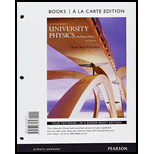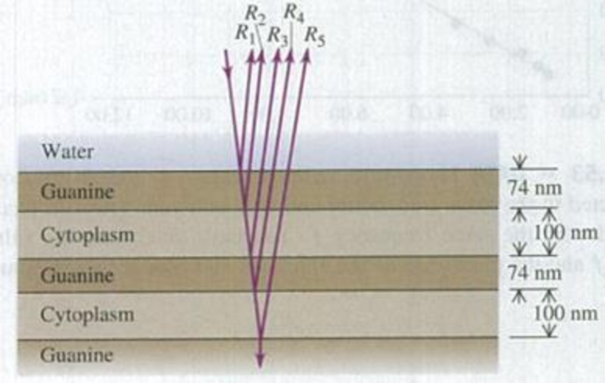
BIO Reflective Coatings and Herring. Herring and related fish have a brilliant silvery appearance that camouflages them while they are swimming in a sunlit ocean. The silveriness is due to platelets attached to the surfaces of these fish. Each platelet is made up of several alternating layers of crystalline guanine (n = 1.80) and of cytoplasm (n = 1.333, the same as water), with a guanine layer on the outside in contact with the surrounding water (Fig. P35.50). In one typical platelet, the guanine layers are 74 nm thick and the cytoplasm layers are 100 nm thick. (a) For light striking the platelet surface at normal incidence, for which vacuum wavelengths of visible light will all of the reflections R1, R2, R3, and R5, shown in Fig. P35.50, be approximately in phase? If white light is shone on this platelet, what color will be most strongly reflected (see Fig. 32.4)? The surface of a herring has very many platelets side by side with layers of different thickness, so that all visible wavelengths are reflected. (b) Explain why such a “stack” of layers is more reflective than a single layer of guanine with cytoplasm underneath. (A stack of five guanine layers separated by cytoplasm layers reflects more than 80% of incident
Figure P35.50

Want to see the full answer?
Check out a sample textbook solution
Chapter 35 Solutions
University Physics with Modern Physics, Books a la Carte Plus Mastering Physics with eText -- Access Card Package (14th Edition)
Additional Science Textbook Solutions
College Physics (10th Edition)
Applied Physics (11th Edition)
Physics for Scientists and Engineers: A Strategic Approach, Vol. 1 (Chs 1-21) (4th Edition)
The Cosmic Perspective
Introduction to Electrodynamics
Cosmic Perspective Fundamentals
- A colloid consists of particles of one type of substance dispersed in another substance. Suspensions of electrically charged microspheres (microscopic spheres, such as polystyrene) in a liquid such as water can form a colloidal crystal when the microspheres arrange themselves in a regular repeating pattern under the influence of the electrostatic force. Colloidal crystals can selectively manipulate different wavelengths of visible light. Just as we can study crystalline solids by using Bragg reflection of x rays, we can study colloidal crystals through Bragg scattering of visible light from the regular arrangement of charged microspheres. Because the light is traveling through a liquid when it experiences the path differences that lead to constructive interference, it is the wavelength in the liquid that determines the angles at which Bragg reflections are seen. In one experiment, laser light with a wavelength in vacuum of 650 nm is passed through a sample of charged polystyrene…arrow_forwardThe coordinates of the four I atoms in the unit cell of KIO4 are (0,0,0), (0,1/2,1/2), (1/2,1/2,1/2), (1/2,0, 3/4). By calculating the phase of the I reflection in the structure factor, show that the I atoms contribute no net intensity to the (114) reflection.arrow_forwardQuartz is a uniaxial birefringent material with refractive indices no=1.5534 and ne=1.5443. It is desired to make a quarter-wave plate of quartz for use with a Sodium laser of wavelength λ0=589 nm. Calculate the minimum thickness of the plate.Give your answer in micrometers to 1 d.p.arrow_forward
- Building contractors often install double-glazed windows to prevent thermal energy (heat) from entering or exiting a building. In addition to being effective insulators, such windows present interesting optical effects. In the figure, a double-glazed window consists of two identical panes of glass (ng = 1.54), each yg = 22.0 mm thick, separated by an air gap of y₁ = 17.6 mm. Use na = 1.00 for the index of refraction of air. If light incident on the glass makes an angle of d = 40.00° with respect to the glass, find the shift in path Ax as the light enters the room. Ax = glass air glass mmarrow_forwardThe index of refraction of a glass rod is 1.48 at T = 20.0°C and varies linearly with temperature, with a coefficient of 2.50 x 10-5C⁰-1. The coefficient of linear expansion of the glass is 5.00 x 10-6C⁰-1. At 20.0 °C the length of the rod is 2.80 cm. A Michelson interferometer has this glass rod in one arm, and the rod is being heated so that its temperature increases at a rate of 5.00 C°/min. The light source has wavelength λ = 569 nm, and the rod initially is at T = 20.0°C. Part A How many fringes cross the field of view each minute? ΔΝ = Submit ΤΙ ΑΣΦ Request Answer < Return to Assignment Provide Feedback ? fringes/minutearrow_forwardStructure factor of diamond. The crystal structure of diamond is described in Chapter 1. The basis consists of eight atoms if the cell is taken as the conventional cube. (a) Find the structure factor S of this basis. (b) Find the zeros of S and show that the allowed reflections of the diamond structure satisfy v, + U2+ Uz = 4n, where all indices are even and n is any integer, or else all indices are odd (Fig. 18). (Notice that h, k, l may be written for v, v2, Uz and this is often done.)arrow_forward
- At a wavelength 692 nm, the ordinary and extra-ordinary refractive indices in a uniaxial crystal are 1.558 and 1.611, respectively. If we make a thin disk of the material, with the optical axis parallel to the plane of the disk, what thickness of disk (in microns) would make a true zero-order quarter-wave plate?arrow_forwardQ3/A/We wish to coat a glass surface with an appropriate dielectric layer to provide total transmission from air to the glass at a free-space wavelength of 570 nm. The glass has refractive index n, = 1.45. Determine the required index for the coating and its minimum thickness.arrow_forwardQ3/A/We wish to coat a glass surface with an appropriate dielectric layer to provide total transmission from air to the glass at a free-space wavelength of 570 nm. The glass has refractive index n3 = 1.45 . Determine the required index for the coating and its minimum thickness.arrow_forward
- In the figure, first-order reflection from the reflection planes shown occurs when an x-ray beam of wavelength 0.820 nm makes an angle θ = 62.3˚ with the top face of the crystal. What is the unit cell size a0?arrow_forwardPotassium chloride (KCl) is an ionic solid with a crystalline structure whose planes are 0.314 nm apart. X-rays of wavelength 0.267 nm are used in a Bragg diffraction experiment to study the crystalline structure. At what angle with respect to the atomic planes in the crystal would you expect the first strong reflection to occur?arrow_forwardA certain type of glass is used in making flat-panel computer monitors. For light with a wavelength in air of 656.3 nm, the refractive index of the glass is nA = 1.5160. For light with a wavelength in air of 435.8 nm, nB = 1.5290. Determine the difference, λA−λB, in their wavelengths inside the glass.arrow_forward
 Principles of Physics: A Calculus-Based TextPhysicsISBN:9781133104261Author:Raymond A. Serway, John W. JewettPublisher:Cengage Learning
Principles of Physics: A Calculus-Based TextPhysicsISBN:9781133104261Author:Raymond A. Serway, John W. JewettPublisher:Cengage Learning
